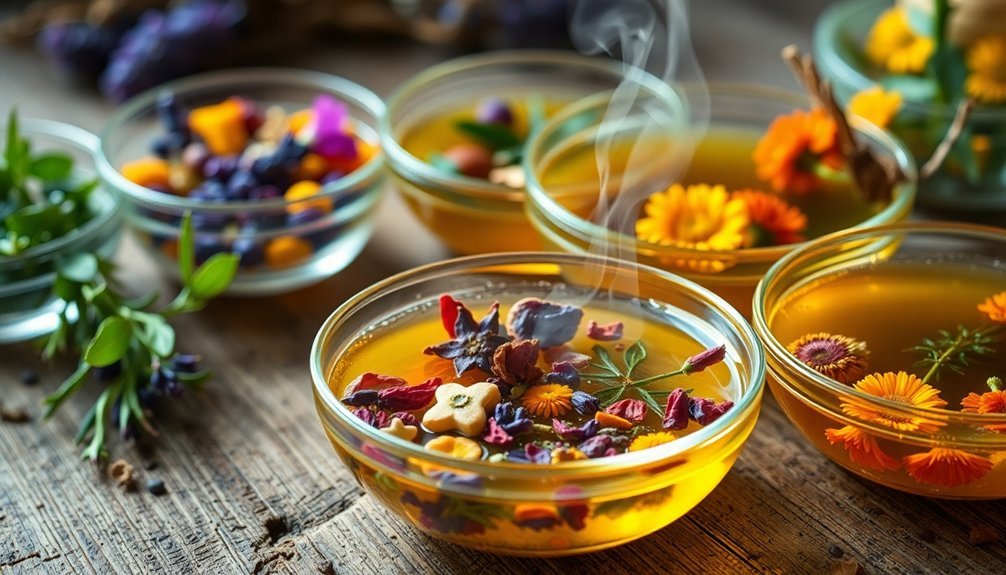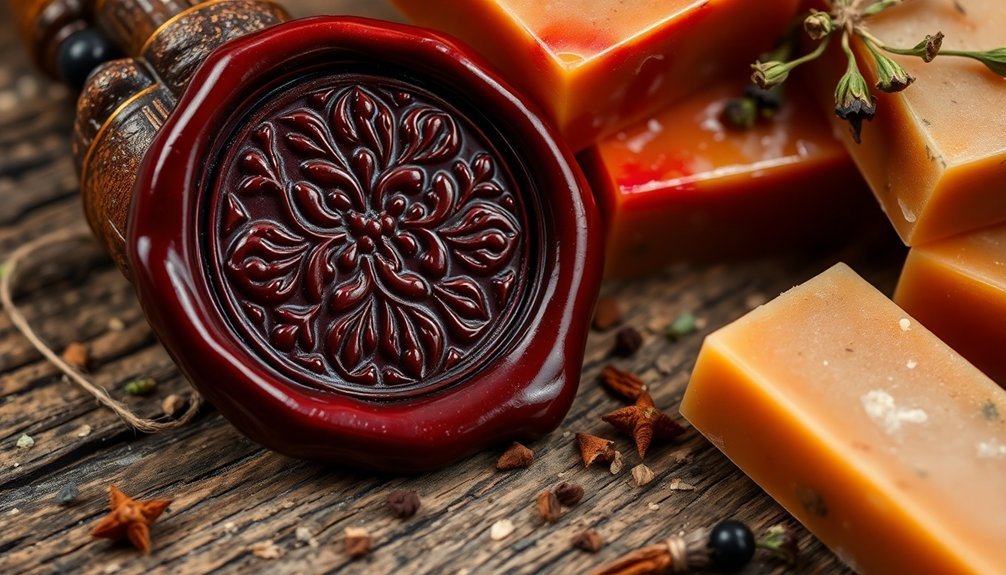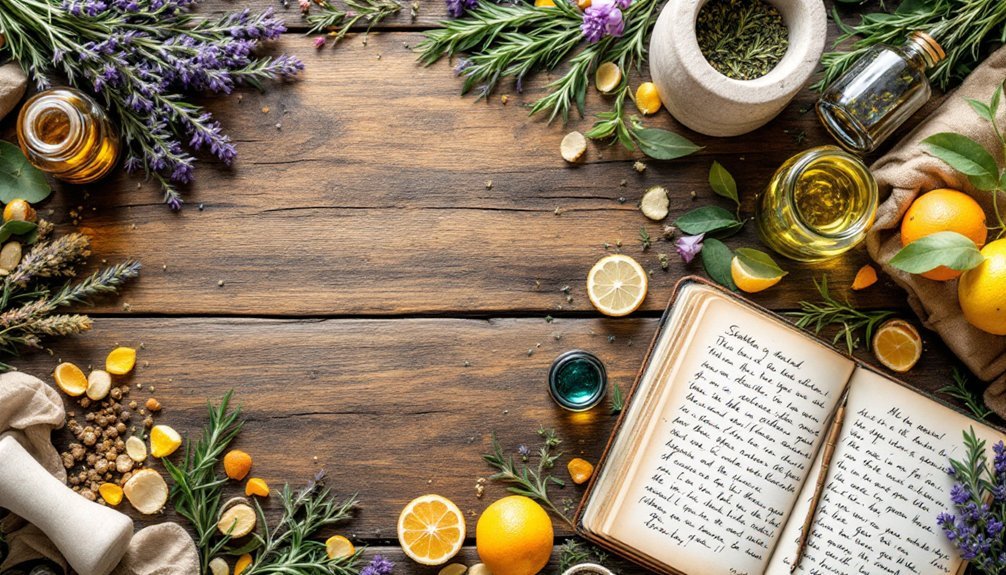Historically, you'll find three excellent methods for scenting handmade bars. First, ancient infusion techniques involve steeping botanicals in carrier oils to preserve delicate aromas. Second, cold-process botanical blending incorporates fragrances at 90-115°F after trace but before molding. Third, wax-sealing techniques create aromatic barriers that lock in scents. These time-tested approaches blend artistry with science, offering a connection to fragrance traditions that span thousands of years across diverse cultures.
The Ancient Art of Infusion: Extracting Scents Through Steeping

While modern perfumery often relies on rapid extraction methods, the ancient art of infusion stands as a demonstration of patience and precision in scent-making. This technique, practiced across Egyptian, Indian, and other ancient civilizations, involves steeping aromatic botanicals in carrier oils to slowly release their essential compounds.
You'll find that infusion preserves delicate aromatic profiles that might be damaged by heat or pressure. The Egyptian practice of enfleurage—pressing flowers into fats—and the Indian Gandhayukti tradition both employed variations of this method to create complex, layered scents for ceremonial and medicinal purposes. Ancient Egyptians considered their fragrance recipes so valuable that they were closely guarded secrets passed down through generations of perfumers.
Today's artisanal perfumers are rediscovering these time-honored techniques. When you're crafting scented bars, consider these traditional methods for creating deeper, more nuanced fragrances that synthetic alternatives simply can't match.
Cold-Process Botanical Blending: Preserving Delicate Fragrances
Cold-process botanical blending stands as one of the most effective methods for preserving nature's delicate fragrances in handmade soap. When you work at temperatures between 90°F and 115°F, you'll maintain the integrity of essential oils and botanicals.
Add your fragrance blends at the right moment—typically after trace but before molding—to guarantee maximum scent retention.
- Use freeze-dried botanicals instead of fresh ones to maintain potency and extend shelf-life
- Create layered fragrances by combining compatible essential oils at 1-5% concentration
- Test your scent preservation before full curing by sampling small portions
Proper storage away from heat and moisture will help preserve the delicate aromas you've worked so hard to capture.
Remember that some botanical colorants, like madder root and Moroccan clay, can enhance both the appearance and aromatherapeutic qualities of your soap. Allowing your soap batch to go through gel phase can significantly enhance the vibrancy of your botanical colors while also helping to lock in fragrance.
Historical Wax-Sealing Techniques for Fragrance Retention

Before modern packaging methods existed, historical artisans developed ingenious wax-sealing techniques that served dual purposes: authenticating contents while preserving precious fragrances.
You'll find that traditional sealing wax combined shellac, turpentine, and chalk with aromatic additions like balsam of Tolu, lavender, and cloves. These essential oils weren't just for scent—they helped control melting points while infusing the wax with distinctive aromas that released when heated.
To apply these fragrant seals, artisans would melt the wax over flame, then press a signet or handheld seal into the warm mixture. The resulting impression not only secured the contents but created an aromatic barrier that helped retain the scents within.
Though practical sealing declined by the 19th century, these techniques preserved fragrance integrity in ways modern methods still emulate today. Historical records show that red was the most popular color for sealing wax, while specialized colors like green were reserved for government and church documents.
Frequently Asked Questions
How Did Medieval Soap Makers Test for Optimal Scent Concentration?
You'd rely on your sensory evaluation, testing soap by smell and feel. You're using proportional mixing, not standardized measurements. You'll gain expertise through trial and experience, as there weren't scientific concentration tests in medieval times.
Why Did Animal-Derived Scents Decline in Historical Soap Production?
You'll find animal-derived scents declined due to their unpleasant odors, limited availability during economic hardships, and the introduction of appealing plant-based alternatives like olive oil and artificial fragrances that consumers preferred.
What Alternatives Existed for Those Allergic to Common Aromatic Materials?
You'd find alternatives in herbal infusions, botanical essences, and fragrance-free options. Chamomile, calendula, and aloe vera provided gentle substitutes. Single-note scents like vanilla or custom blends of milder oils were also available for sensitive skin.
How Did Geography Influence Regional Soap Scenting Traditions?
Geography shaped soap scenting dramatically—you'll find regions used locally available plants by necessity. Mediterranean cultures preferred olive-based soaps with herb scents, while Middle Eastern traditions utilized desert plants and exotic spices along trade routes.
Did Royalty Commission Special Fragrance Blends for Personal Soaps?
Yes, royalty did commission custom fragrance blends. You'll find that monarchs like Marie Antoinette and Louis XIV employed personal perfumers who created exclusive scents reflecting their status and addressing their skin sensitivities.
In Summary
You've now explored three time-tested techniques that connect you to soap-making traditions spanning centuries. Whether you're steeping botanicals, carefully blending essential oils into cold process batches, or applying historical wax-sealing methods, you're participating in an aromatic heritage. These methods offer authenticity that synthetic fragrances can't match. Try incorporating these approaches in your next batch—your senses will appreciate the connection to soap-making's rich history.





Leave a Reply